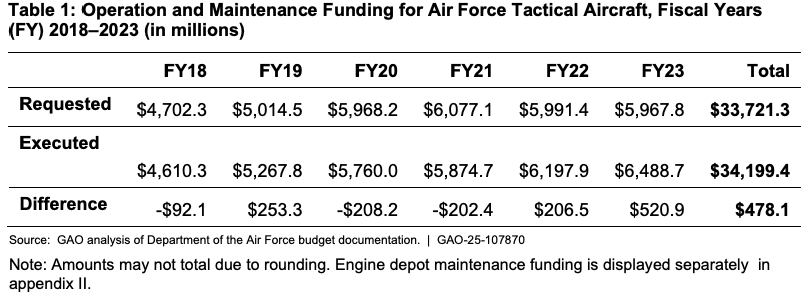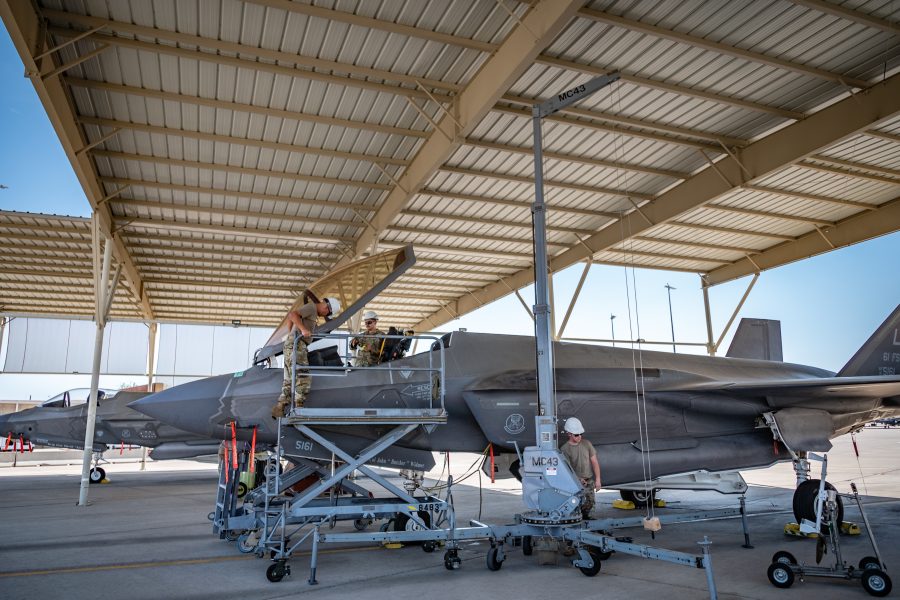The Air Force ramped up operations and maintenance spending to keep its F-35A fighters flying over the past six years, but readiness continues to lag behind goals, according to a new report from the Government Accountability Office.
Indeed, the Air Force is spending more and more to sustain its entire fighter fleet, but has seen only middling gains in mission capable rates, which measure the percentage of time an aircraft can fulfill at least one of its missions, the government watchdog found.
GAO did not include precise, year-by-year figures on sustainment funding and mission capable rates by aircraft type in its public report, bowing to concerns from the Pentagon that deemed that data sensitive. But the analysts noted that:
- O&M funding requests rose almost 27 percent from fiscal 2018 to 2023 for to sustain A-10, F-15, F-16, F-22, and F-35A aircraft;
- O&M spending outstripped those requests during that period, rising by 40.7 percent;
- And all told, the service spent nearly $34.2 billion on fighter sustainment—not including engine depot maintenance, service life extension programs, and certain spare parts procurement.
Yet that jump in spending also came at a time of high inflation, erasing many of the increases.
Not once in that period did any of the Air Force’s F-15E, F-22, and F-35A fighters meet their objective mission capable rate. The aging F-15C and F-16C fleets hit their marks three times, meanwhile, and the A-10, F-15D and F-16D all met their goals once.

Sustainment troubles also plagued the Navy and Marine Corps, according to GAO, which found that “none of the 15 tactical aircraft variants [across the services] met their mission capable goals in fiscal year 2023.”
Air Force leaders counter that mission capable rates are just one way of measuring readiness across different units, and that changes in the way rates are calculated contributed to the negative picture. The F-35 Joint Program Office, responsible for overall F-35 sustainment, has pushed back on prior GAO criticism, arguing that sustainment costs are coming down.
Still, availability issues with the F-35 were already deemed bad enough In March 2023 for the JPO to declare a so-called “War on Readiness,” with the goal of increasing mission capable rates by 10 points, to 64 percent, within a year.
It wasn’t to be. The Air Force said this summer its F-35A fleetwide mission capable rate was 51.9 percent in fiscal 2023—down from prior years and below its goal. Now, the GAO reports that during that fiscal year, the Air Force exceeded planned O&M spending on the F-35 by nearly 7 percent.
Steady increases in projected sustainment costs for the F-35 are not unexpected, given that the size of the Air Force fleet is growing over time. Yet for four years in a row now, the service has spent more than expected on operations and maintenance for the Lightning II.
The Air Force also has spent more than requested on F-22 sustainment while still missing its mission capable goals. USAF is planning billions of dollars in Raptor upgrades and modernization in the coming years, now that it’s clear the aircraft will be needed longer than previously anticipated. The Air Force took a “pause” on its Next-Generation Air Dominance Platform, meant to replace the F-22, this summer potentially setting that project back by several years.
The only aircraft on which the Air Force spent significantly less than projected was the A-10, with costs falling 13.5 percent below expected. The A-10 fleet is gradually being retired.
Costs for the F-15 and F-16 fleets came in basically on target, as USAF divests its F-15C/D fleet.
GAO noted the apparent disconnect between rising sustainment spending and stubbornly low aircraft readiness.
“The variances observed between the executed and requested amounts for tactical aircraft are not meaningfully associated with mission capable rates,” the watchdog report states.


